Skip to content
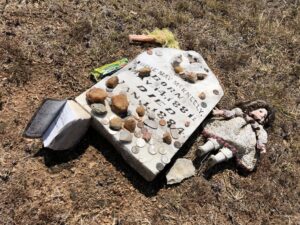
Happy October!
Especially around Halloween, folklore seems to become more popular and tales that hint of gruesome details are told and retold.
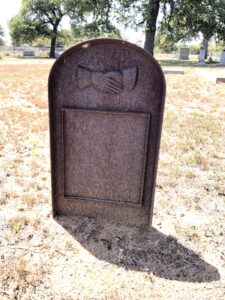 Such is the fate of the origin of Babyhead Cemetery in the Texas Hill Country. Now admittedly when you put those two words together a gruesome backstory seems to be guaranteed. I’ll let you decide.
Such is the fate of the origin of Babyhead Cemetery in the Texas Hill Country. Now admittedly when you put those two words together a gruesome backstory seems to be guaranteed. I’ll let you decide.
The cemetery is about ten miles north of Llano, in an area where the town of Babyhead once stood, by a mountain of the same name. In the mid-1800s it was a respectable size settlement, with a school, post office, courthouse and a few businesses. It eventually faded away and became a ghost town, with the remaining few citizens being absorbed into the city of Llano.
All that’s left of the community is a cemetery. Babyhead Cemetery. A place visited by more ghost enthusiasts than historians.
The Story
Local tradition shared that the town got its name in the 1850s, when a small child was kidnapped and killed by Indians trying to discourage settlers. Most versions include the grisly detail that the child’s head was left on a stake at the base of the mountain as a warning. Legend has it that the town was named in her memory.
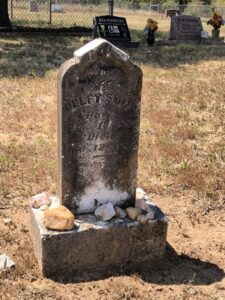 The cemetery today has a few dozen well-kept but weathered graves that date from the early 2000s back to the oldest – that of a child named Jodie May McNeely who died on New Year’s Day in 1884.
The cemetery today has a few dozen well-kept but weathered graves that date from the early 2000s back to the oldest – that of a child named Jodie May McNeely who died on New Year’s Day in 1884.
Now we all know the old game of “telephone” or “post office” where one person says something, the next repeats it but a few facts change and so on. That’s how most local legends take shape.
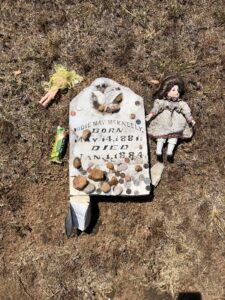 Young Jodie’s grave is the one many visitors associate with the grim story, and that’s where they leave remembrances…dolls, toys, cards, candy…all for the child who they associate with the tale of another child who lost her life much too soon.
Young Jodie’s grave is the one many visitors associate with the grim story, and that’s where they leave remembrances…dolls, toys, cards, candy…all for the child who they associate with the tale of another child who lost her life much too soon.
But at least Jodie is being visited.
A Texas State Historical marker was placed at edge of the cemetery in 1991 that shares a brief version on the story.
Another Option
Unless it was a community of ghouls, it would be very strange indeed to name your town, post office and even your children’s school Babyhead if the event truly occurred.
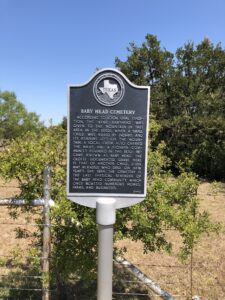
There is a large creek that runs past the former townsite. Remember that a moving body of water is referred to as a “head.” Unusually, this site also has a smaller creek that runs toward it nearby, right where Babyhead Road is today.o m
Hmmmm…..so if the major water was referred to as the Head, perhaps the settlers referred to the smaller creek as the Baby Head. Seems to make sense to me.
But legends and offerings persist, and really…who knows? You’ll have to decide for yourself.
Would you visit a cemetery named Babyhead?


Welcome to Terlingua Cemetery, in Terlingua Texas.
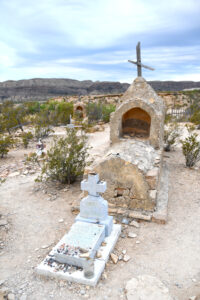 To those who are more accustomed to manicured cemeteries with vast green lawns, this place appears to be abandoned, but Terlingua cemetery is still in use today.
To those who are more accustomed to manicured cemeteries with vast green lawns, this place appears to be abandoned, but Terlingua cemetery is still in use today.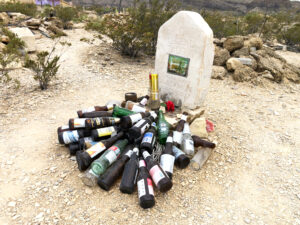
It’s one of the most photographed graveyards in the state of Texas, which should come as no surprise.
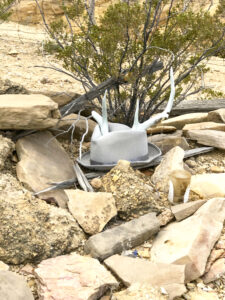 I’ve wanted to visit this amazing burial ground since I was a child, so to have the opportunity to roam through it – left alone with my thoughts and wonder about those who rest here – was a true privilege. There are the well-known, the unknown and the surprise of finding the grave of someone I knew personally in college. It was an astounding experience.
I’ve wanted to visit this amazing burial ground since I was a child, so to have the opportunity to roam through it – left alone with my thoughts and wonder about those who rest here – was a true privilege. There are the well-known, the unknown and the surprise of finding the grave of someone I knew personally in college. It was an astounding experience.
Terlingua was one of the most remote areas in North America at the time it was founded. It still remains set apart from more populated areas.
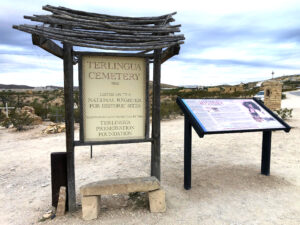 The cemetery encompasses one acre in the Terlingua Ghost Town – which isn’t really a ghost town at all. True . . . the town used to be the site of a quicksilver mining camp and place where desert folk called home beginning in the 1880s, but it’s now more of an artist community and a low key tourist base for visiting Big Bend National Park.
The cemetery encompasses one acre in the Terlingua Ghost Town – which isn’t really a ghost town at all. True . . . the town used to be the site of a quicksilver mining camp and place where desert folk called home beginning in the 1880s, but it’s now more of an artist community and a low key tourist base for visiting Big Bend National Park.
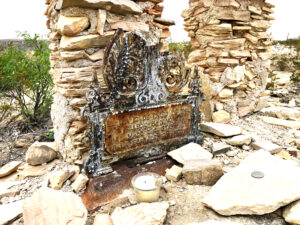 Marked graves date back to 1903, but burials began back when the dangerous process of mercury mining began here. Mine collapses, mercury poisoning and later influeza and tuberculosis epidemics populated the cemetery.
Marked graves date back to 1903, but burials began back when the dangerous process of mercury mining began here. Mine collapses, mercury poisoning and later influeza and tuberculosis epidemics populated the cemetery.
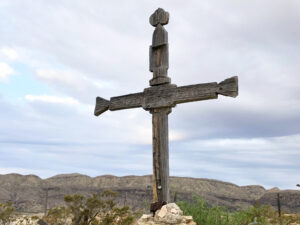 Conservative estimates say that there are about 400 burials in the cemetery: Men, women, and children. Miners, goat herders, artists, housewives, ranch hands, cooks, bootleggers, day laborers, war veterans, clergy, even murder victims. About 90 percent of those who rest here are of Hispanic heritage.
Conservative estimates say that there are about 400 burials in the cemetery: Men, women, and children. Miners, goat herders, artists, housewives, ranch hands, cooks, bootleggers, day laborers, war veterans, clergy, even murder victims. About 90 percent of those who rest here are of Hispanic heritage.
Those that were victims of mining accidents were sometimes laid to rest in coffins made by the companies they worked for.
Many of the gravesites have lost their markers, or they have simply become illegible over time. Some have all but vanished due to relentless weather and relic hunters.
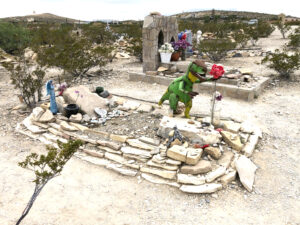 Others reflect the character and sometimes humor of those who they remember. A Hobbit hole, a metal T-Rex, and epitaph of “Another good man done gone.” They all lure visitors into slowing down to take in the silent stories of the cemetery.
Others reflect the character and sometimes humor of those who they remember. A Hobbit hole, a metal T-Rex, and epitaph of “Another good man done gone.” They all lure visitors into slowing down to take in the silent stories of the cemetery.
The Mining town was abandoned in the 1940s. That’s when Terlingua became a true ghost town . . . years before it became home to artists and others who tired of life in overcrowded communities . . . and eventually the visits of countless curious tourists on their way to Big Bend.
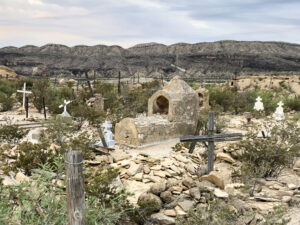 Visitors are fascinated by the variety of burial markers and folk art memorials, and of course – the stunning View of Chisos Mountains and Sierra del Carmens as a backdrop.
Visitors are fascinated by the variety of burial markers and folk art memorials, and of course – the stunning View of Chisos Mountains and Sierra del Carmens as a backdrop.
Each year an elaborate celebration takes place here to mark Dia de los Muertos, or Day of the Dead, giving the living a chance to honor and remember the departed.
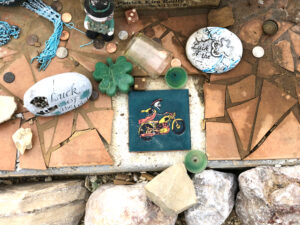
Walking into Terlingua cemetery is like walking into a time warp. If a visit to this fascinating place doesn’t make a person stop and reflect . . . I’m not sure what would.
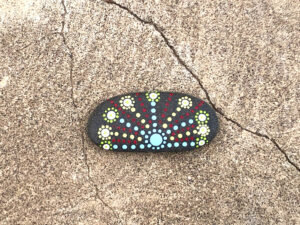
Join me for a stroll through the grounds of this historic cemetery in my Youtube video of the cemetery HERE.
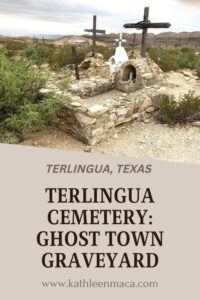

 To those who are more accustomed to manicured cemeteries with vast green lawns, this place appears to be abandoned, but Terlingua cemetery is still in use today.
To those who are more accustomed to manicured cemeteries with vast green lawns, this place appears to be abandoned, but Terlingua cemetery is still in use today.
 I’ve wanted to visit this amazing burial ground since I was a child, so to have the opportunity to roam through it – left alone with my thoughts and wonder about those who rest here – was a true privilege. There are the well-known, the unknown and the surprise of finding the grave of someone I knew personally in college. It was an astounding experience.
I’ve wanted to visit this amazing burial ground since I was a child, so to have the opportunity to roam through it – left alone with my thoughts and wonder about those who rest here – was a true privilege. There are the well-known, the unknown and the surprise of finding the grave of someone I knew personally in college. It was an astounding experience. The cemetery encompasses one acre in the Terlingua Ghost Town – which isn’t really a ghost town at all. True . . . the town used to be the site of a quicksilver mining camp and place where desert folk called home beginning in the 1880s, but it’s now more of an artist community and a low key tourist base for visiting Big Bend National Park.
The cemetery encompasses one acre in the Terlingua Ghost Town – which isn’t really a ghost town at all. True . . . the town used to be the site of a quicksilver mining camp and place where desert folk called home beginning in the 1880s, but it’s now more of an artist community and a low key tourist base for visiting Big Bend National Park. Marked graves date back to 1903, but burials began back when the dangerous process of mercury mining began here. Mine collapses, mercury poisoning and later influeza and tuberculosis epidemics populated the cemetery.
Marked graves date back to 1903, but burials began back when the dangerous process of mercury mining began here. Mine collapses, mercury poisoning and later influeza and tuberculosis epidemics populated the cemetery. Conservative estimates say that there are about 400 burials in the cemetery: Men, women, and children. Miners, goat herders, artists, housewives, ranch hands, cooks, bootleggers, day laborers, war veterans, clergy, even murder victims. About 90 percent of those who rest here are of Hispanic heritage.
Conservative estimates say that there are about 400 burials in the cemetery: Men, women, and children. Miners, goat herders, artists, housewives, ranch hands, cooks, bootleggers, day laborers, war veterans, clergy, even murder victims. About 90 percent of those who rest here are of Hispanic heritage. Others reflect the character and sometimes humor of those who they remember. A Hobbit hole, a metal T-Rex, and epitaph of “Another good man done gone.” They all lure visitors into slowing down to take in the silent stories of the cemetery.
Others reflect the character and sometimes humor of those who they remember. A Hobbit hole, a metal T-Rex, and epitaph of “Another good man done gone.” They all lure visitors into slowing down to take in the silent stories of the cemetery. Visitors are fascinated by the variety of burial markers and folk art memorials, and of course – the stunning View of Chisos Mountains and Sierra del Carmens as a backdrop.
Visitors are fascinated by the variety of burial markers and folk art memorials, and of course – the stunning View of Chisos Mountains and Sierra del Carmens as a backdrop.








